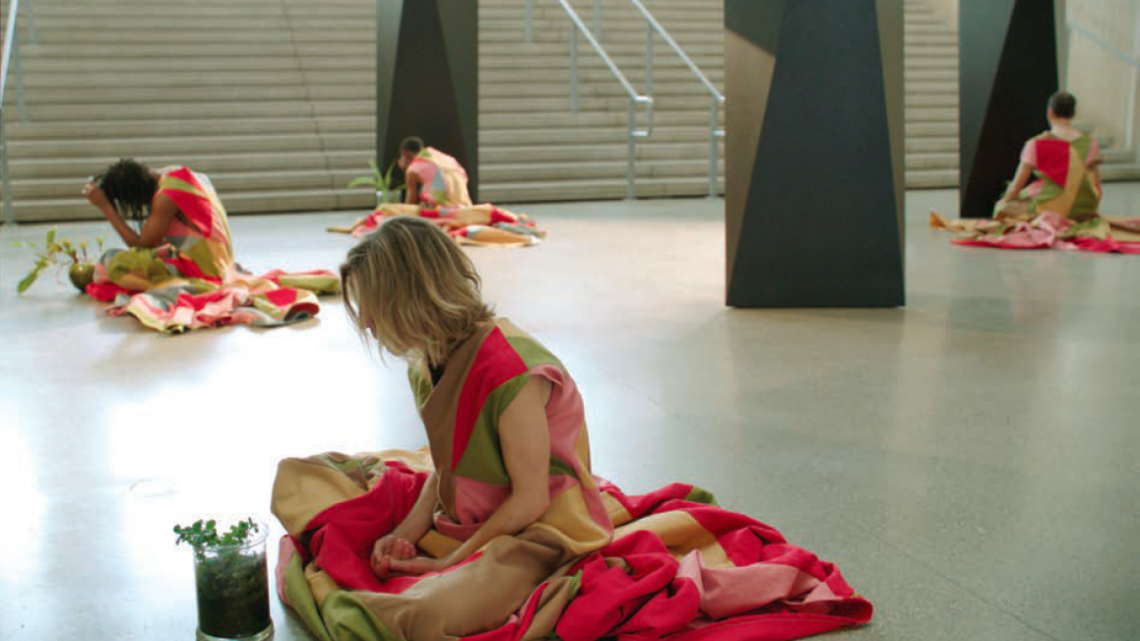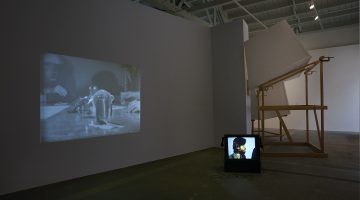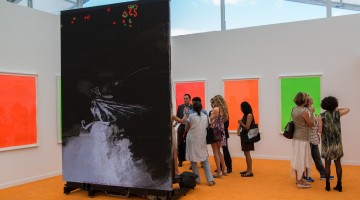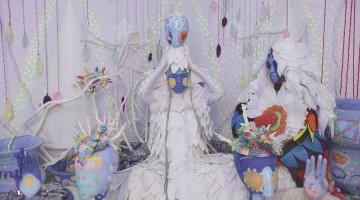In artist Fayen d’Evie’s performative lecture, “The Levity, The Gravity” (Kadist, January 16, 2016), she describes the historic journey of haptic practices within art viewing, from a 17th and 18th century world of touch to our contemporary hands-off museum practices.1
D’Evie’s lecture is part of Kadist’s ongoing, cross-disciplinary, inquiry-based project “HANDS ON,” that also includes writer and professor Georgina Kleege and Kadist curator Devon Bella. Aiming to “investigate the cultural history, social politics and radical potential of tactile perception and haptic encounters with artworks,” the project is multi-faceted, not only facilitating access to Kadist’s collection for low-vision and blind communities, but also inviting general audiences to reflect on “tactility and alternatives to the ocular-centric norms of exhibiting.”2
That d’Evie and Kadist’s interest in and development of haptic description arises when we are becoming more and more screen oriented is almost radically counter-intuitive. While the screen experience relies on the ocular, haptic handling implies an inquisitive, formal analysis of an object’s tactile qualities. In the 19th century, museums adopted a hands-off policy when their collections became open to larger populations. Prior to that, touching was often included as part of the viewing experience. Visitors to a private collection would pick up, hold, and touch, gaining information through the multi-sensory feeling of an object. Constance Classen notes, “When the underkeeper of the Ashmolean in 1760 tried to prevent a museum visitor from handling artifacts he was accused of incivility.”3
Currently, museums and art institutions are digitizing their collections so that people can view them online, thus allowing more people to potentially view more artworks. While this practice increases accessibility, it also poses questions about what the viewer actually sees within an online experience as scale, texture, dimensionality, luminosity, and other key elements are reduced to the framework of a screen, whether laptop, phone, or tablet. Like the development of the hands-off policy, which eliminated touch from exhibition practices, the digitizing of artwork reduces numerous physical aspects so that the viewer loses crucial pieces of information about a work of art. Looking at an artwork on screen makes it equivalent to any other image a viewer encounters via the Internet whether it’s a J.Crew bathing suit, a juicer, or a hospital bed. The content might be different but the surface qualities of the image will be the same.
One of d’Evie’s key references is Robert Hooke, a 17th century naturalist, surveyor, philosopher, polymath, and curator of experiments at the Royal Society. Hooke, in evaluating his own moment, saw a problem amongst his peers and their practices. In his essay, “The Present State of Natural Philosophy and wherein it is deficient,” Hooke describes a danger in “a contentment with superficial description.” He goes on to say, “descriptive casualness has compromised not only the advancement of knowledge about natural phenomena but indeed the descriptions of almost all things.” The antidote is “diligent attention not just to ocular inspection but to manual handling.” D’Evie continues, “And it is in this regard that levity and gravity appear amidst a taxonomy of tactile qualities not habitually mentioned within contemporary art criticism the clamminess, the slipperiness, the moistness, the brittleness, the dullness, the sonorous. . .”4 All of these words describe experiences specific to touch—its emotive expansiveness, its temporality, its ephemerality—as to touch is to locate an object within time and space, to locate otherness.
D’Evie’s lecture concerns the art object, art criticism, and museum practice, but it can easily be applied to our digital world where the ocular has surpassed the touch as a primary means of knowing. Many people spend their lived time in front of a computer, looking at the flat, smooth, vaguely warm screen—its frame rate consistent, its shape stable, its body comfortably hard, its glow familiar. Our reliance on the screen for information produces our own descriptive casualness. We are far removed from the 17th century world of touching, of sensing clamminess, moistness, or humidity. We are server room dry, even after a virtual rain. This maybe why so many of the touch remnants of the 20th century now appear as a kind of consumer nostalgia—a desire to purchase artisanal foods, to bury fingers in the wet, rotting dirt of organic gardens. From knitting to glazing thick ceramic cups, people seem to crave the work of the hand, the specificity of something once touched, crafted by human inconsistency, and bound by time. Maybe this unconscious desire for surface substance, for spaces predisposed to bodily accumulation explains the proliferation of beards on some fashionable men; the curling, sponging, smell-absorbing hairs provide relief from all of the smooth, textureless screens.
Hooke’s comment about the compromises of description, of what is lost when “manual handling” is no longer part of our production of knowledge provides a lens through which to look at our screen-dominated, ocularly focused culture. What is compromised when the screen-image supersedes all other forms of communication? What happens when stores, products, people are known not by name but by icon? What is compromised by our descriptive casualness, our over-reliance on the photo or the screen? During a Kadist workshop lecture on July 22, 2016, d’Evie noted that one should consider accessibility not in terms of simply blindness but instead, of accessing the work from a multiplicity of experiences and perspectives. D’Evie’s framework for haptic or corporeally based art appreciation acknowledges what is lost when sensory information is limited to the eyes when we let the eye become the totality of the “I.”
If a picture is worth a thousand words, then it is probably missing a million sensations. Some call Instagram by the emotion it produces, Envyagram, especially as lives become lifestyle brands, and commodification seeps into notions of self, relationship, and action. A photograph of a woman eating a peach, sitting on a wooden porch, sun-lit, amongst lavender and hummingbirds looks like a bucolic ideal, perhaps, stirring desire within the viewer, a passing want of that same scene for themselves. Yet, to actually sit in the sun, to feel its warmth, possibly to the point of sweating, to catch the shifting light on your shoulder, mildly hot-cold, to negotiate the fragile, sweet texture of peach on your tongue, to brush your feet against the sometimes splintery wood porch is to be present: to touch, and to be touched. To be there is not to envy the moment but instead to stamp oneself in it. You are there and only there. It is the opposite of a networked, image-based culture where information and relationships are dislocated, fragmented, and dispersed.
An ad for the iPhone 6s illustrates the fragmentation that the digital world provides, the young boy being fractured and reproduced, only able to locate himself within a hall of mirrors by touch. He uses his hands, not his eyes to locate himself. We never see the child in his entirety; his wholeness is divided in the image just as it will be when it is sent across the invisible network, (I)phone, the eye/I within the device, the phone, pad, book. Within a matter of moments, the photographer of this photo sends this image of this boy as packets into the wired clouds around us. His self: captured, split, and dispersed to an unknown cadre of viewers, scattered, only to arrive moments later on another screen, momentarily whole.
Within a gallery setting, there is a profound difference between looking and touching. At the Kadist workshop on July 22, 2016, participants were able to touch selected works from Kadist’s collection. Touching Pia Camil’s Espectacular cortina (2012) brought its sensual, handwork quality to life, its fabric soft, comforting, and inviting. Gently feeling the seams which held the patchwork panels together made the work less abstract, more connected to its production, its hand-crafted origins in the work of the seamstresses who Camil hires. The title refers to billboards and wall-scale advertisements seen from passing cars and walking feet. After the paid period expires, the billboard owners rework the panels serendipitously creating abstract murals. This is one way to view the work—from a distance. Another way, by touching, provokes thoughts about the hands which turn the panels, the human-beings behind both the creation of the piece and of the advertisement, bringing the work closer to the corporeality of labor.
The group watched the video Future Gestalt (2012), the document of a performance work by Brody Condon. The piece features actors who have been through a series of aesthetically focused psychotherapy sessions and a role-playing workshop. Through these explorations, the actors developed characters with unique communication styles varying from clicks to poetic free association. The actors interact with one another and also with Tony Smith’s immense, architecturally scaled, black steel sculpture Smoke (1967) which represents their group leader. They wear costumes with geometric patchworks of muted pink, beige, yellow, and green.
Next to the screen, a reproduction of a costume from Future Gestalt was laid on a plinth. Toward the end of a verbal description and discussion of the video, one low-vision workshop participant asked why nobody had picked up the costume. Was it fear of touching? Fear of being seen touching? Did we feel it wasn’t our turn? What prevented us from handling an object even though we were at the workshop specifically to touch?
At that point, another participant said she wanted to wear the costume. Several people helped her put the heavy, canvas dress over her head. Once it was on, it changed the dynamic of the room and our discussion of the piece radically. Her description of the costume’s weight related back to the actors within the video, the quality of their movements, their ability to drag one another across the floor. It brought the conversation back to the corporeal connections between not only the participants in the room, in real time, but between the people on the screen. It gave the participant wearing the costume authority within the group; she now served as a focal point and knowledge producer. She became a performer, a meta-performer, co-author and co-creator of the moment, prompted by the Condon’s work and the spontaneous interaction of the haptic encounter. She was the embodiment of future gestalt.
In a culture dominated by image and images, where the screen has overtaken the physical—from our friendships to our sex lives—touch enables access to the present. Touch breaks up our connection to the ever-connected digital ether that links us together, wrecked and ruined in disjointed harmony. The individual, the group, momentarily pulling away, pulling together, pulling toward everything and nothing, desperately hoping there is a there, there—on the cloud, within a media feed, beyond the screen.
While the digital world networks us seamlessly together, touch is all seams, it constantly reifies the differences between surfaces, the point where one object starts and another one ends. While the digital world consists of fragments, of data packets, of omnipresence, touch grants the illusion of wholeness, containment, location, and time. Touch can be a portal into our ontological past.
Georgina Kleege, a legally blind professor at UC Berkeley, has developed a language for haptic description. As part of HANDS ON, she has led several touch tours.5 To watch Kleege physically move through an object reveals the dynamic and perceptive action of touch as completely unique from sight. Kleege sees the object with her hands, fingers, language, and imagination. She makes us aware that lightly tracing with fingertips is an action distinct from grasping or clutching. It’s a type of seeing that is located directly in the mind, in language, and in the physical senses, which, unlike our sight, are not yet networked.
In Kleege’s touch tour, the act of touching requires physical space. Kleege needs space and its distance to distinguish herself from the object. In Henri Bergson’s, Time and Free Will: An Essay on the Immediate Data of Consciousness, he argues that space is a prerequisite to time, that “externality is the distinguishing mark of things which occupy space” and this externality is necessary for our ontological distinguishment and movement through time as “in order to perceive a line as a line, it is necessary to take up a position outside it, to take account of the void which surrounds it, and consequently to think of a space in three dimensions?”6 In psychoanalytic theory, the subject object relationship is a fundamental concept; one of the infant’s first acts of selfhood is to distinguish itself from its mother. Merging with others and objects signifies mental illness.
As the spaces between objects diminish through the emergence of lived digital space, objecthood and selfhood will take on new definitions and in Bergson’s argument, new consciousnesses. The collapsing and merging of real and screen space in a game like Pokémon GO evidences new ideas around objecthood and space; the game player existing in real space with real objects, the game and its objects existing in screen space. The two-dimensional screen space taking active precedence over the three-dimensional lived space as evidenced by the robberies and accidents which gamers have experienced during their immersive game-play. Within the game, an avatar of the player appears on screen, moving with the player as she moves through real space thus splitting or doubling the person in two places—on the street and on the screen. Walking, the feet hitting the pavement, simulates the computer avatar’s movement. The whole game structure, held together by Google’s global positioning mapping system, perfectly ties multiple streams of data into a representative holistic experience for the player. This active reproduction of self and dispersion of self within multiple locations in a new experience maybe only analogous to the act of reading where one projects oneself into a narrative.
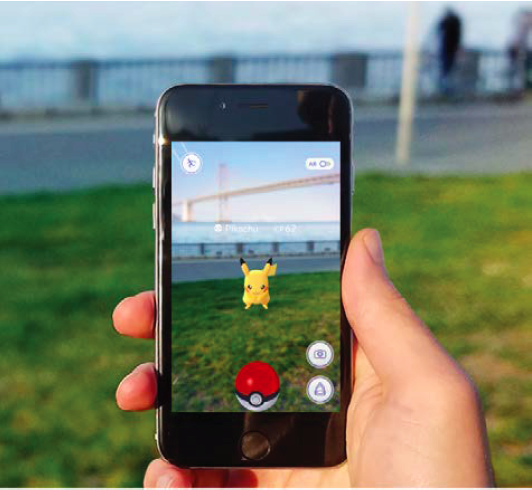
Pokémon GO screen in action. Courtesy of the Internet.
Touch reinstates the subject/object relationship, which is obscured within a digital framework and can re-assert a different experience of self. Mark Poster employs this concept when discussing the use of the typewriter versus the keyboard: “(t)he shift from the typewriter keyboard to the computer keyboard is ontological: the former instantiates and reinforces a subject-object. The paper page receives the mechanical blows of the keys as the writer presses on the machine and produces an inked page . . . The computer keyboard, by contrast, sends digital signals to a central processing chip through a word processing program, producing letters on the screen that lack the material properties of the typed paper page.”7 If we imagine this in haptic terms, a person could theoretically read a typed piece of paper by tracing the letter forms. Motion, three-dimensional space, and touch are all necessary components—all of which are compromised and circumscribed within digital communication. You cannot touch a screen to know what is written on it.
Blind people produce knowledge in a way that utilizes their senses and conceptualization in a manner different from the sighted. Their unique access to the world makes them a well-spring of information and also offers modes of conceptualization that produce new types of knowledge or knowledge which the sighted can’t see until it is described by a blind person. Denis Diderot, the 18th century French philosopher, had a famous relationship with a young blind woman in which he was continually impressed by the depth and sophistication of her descriptions and experiences of the world. Kleege writes: “Diderot valued his blind informant not because she conformed to his previously held theories but because she compelled him to examine all that he took for granted. In comparing his imagination to hers, he was not seeking a mirror image. If her mental images differed from his own, it did not make them any less vivid or useful. He accepted that Mademoiselle de Salignac would have developed ways to conceptualize the sighted world. His dealings with her suggest that he was teetering on the edge of conceptualizing blind perception, grappling with ideas about outward reality and inward representations, and the complex interplay between words and images.”8 Kleege understands that modes and uses of the senses produce different types of knowledge, that information is generated by our collective senses, our ontological state.
Tactile experience locates the body in analog time and space. It reinforces a certain type of ontological being predicated on the idea of the whole. In his 2016 article, “Feel Me: What the New Science of Touch Says about Ourselves,” Adam Gopnik writes: “Our skin is us because it draws a line around our existence: we experience the world as ourselves. We can separate our self from our eyes and ears, recognize the information they give as information, but our tactile and proprioceptive halos supply us with the sense that we are constant selves.”9 The tactile has yet to be fully networked nor do we have general access to technology, which would disperse our sense of being touched and touching over many, physically discontinuous spaces. At this point in time, most of us can only touch a limited number of people or objects at once. More importantly, we can still, at times, imagine our body as being a continuous surface, which encloses us and gives us shape.
The haptic experience seems, possibly, to be the foil in which the viewer can override the sense of a fragmented, omnipresent self, produced by networked capitalism or in Gilles Deleuze’s term, societies of control. By using the sense of touch, the viewer can re-form a sense of wholeness by recapturing a subject/object relationship based within a lived space. For the moment, touch sits outside of networked capitalism although it will quickly become part of our digital ensemble. Before touch becomes virtual, we can relish its ability to place us within time, moment by moment. It exists as a spontaneous, irreproducible exchange between humans, between humans and animals, between humans and nature, and between humans and objects. Touch has not yet been turned into an endlessly reproducible experience, another easy commodity to embed within the digital network, but that is coming.
Gopnik’s article describes the technological possibilities of reproducing touch. In the article he quotes a researcher whose goal is “to provide robots with more than mere mechanical expertise. She wants them to have ‘haptic responsiveness,’ so that the surgeon operating the robot can feel in her own hands the bounce or flab of an internal muscle, or palpate a liver from long distance.” She goes onto say, “Haptic intelligence is vital to human intelligence. . . . It’s finding your way in the world: it’s embodiment, emotion, attack.”10
In the future, human touch will be usurped by virtual touch. Like our images, our touch will be online. We will be able to disperse our sense of touch through a digital network. This has profound implications for tactile visuality—one can imagine museum-goers being able to touch and handle works of art via haptic simulation. It also has even broader implications for our ontological selves as we are able to replicate, reproduce, and disseminate our touch in the same way we currently do our images—an Instagram of touch.
As our bodily senses become more and more dispersed from our corporeal selves, integrated with technology, non-nation state, corporate-based capital, machine intelligence and as seeing, touching, speaking, intuiting machines take on the corporeal acts of the body, the implications for our identities, perception of self, sensing, and production of knowledge are unknown and many. In his essay, “Postscript on the Societies of Control,” Deleuze uses the mole to represent the analog world of the 19th and early 20th centuries. He employs the serpent as the representative animal for the societies of control. The mole is a low-vision creature, traveling dark passageways by touch, smell, and sound. Serpents do not have arms, hands or fingers, their bodies, a continuous loop of touch. Deleuze describes the man of the societies of control as “undulatory, in orbit, in a continuous network.”11 The man, the snake both moving by undulation, no legs, no feet hitting the ground, the space between the body and earth diminished to almost nothing.
At one moment in her touch tour, Georgina Kleege refers to the “digital.” For a moment, I thought she meant zeros and ones, data, but she meant her fingers. Digital for Kleege re-asserts the primacy of our physical bodies, our hands, our fingers, our touch, a specific experience, a type of holistic integrated knowledge production. Digital in the new technology definition implies the opposite—the non-body, bits and pieces of information which may or may not produce knowledge but circulate data to be interpreted by any number of people in any number of ways in an infinite amount of spaces. Deleuze describes the digital functioning as such: “We no longer find ourselves dealing with the mass/individual pair. Individuals have become ‘dividuals,’ and masses, samples, data, markets . . .”12
Our digital world(s) give us information and experience—one the currently analog realm of touch, the other “undulatory, in orbit, in a continuous network.”13 For the moment, the haptic experience might enable us to see like moles with our fingers, our language, our imagination and our temporal selves. The mole relies on its tiny hands and claws to dig its way through the earth, scraping, pawing, pushing its appendages, providing crucial contact with the world. In the future, we might be armless snakes, seeing and touching through a continuous, infinite networked loop where we can feel with hands not our own. As our senses evolve and we develop our sense of self, as we see and feel through new technologies, we may no longer be moles warmed by our blood but receptive reptiles heated by a digital sun. Who knows what we will see?
1) Fayen d’Evie, “The Levity, the Gravity,” https://vimeo.com/154934985.
2) Both quotes, Devon Bella and Fayen D’Evie, “Hands On/ Hands Off/ Hand Over: Proceeding from Touch,” p. 1.
3) Constance Classen, editor, The Book of Touch, as cited in Adam Gopnik, “Feel Me: What the New Science of Touch Says about Ourselves,” The New Yorker, May, 16, 2016, p. 61.
4) Fayen d’Evie, “The Levity, the Gravity,” https://vimeo.com/154934985.
5) https://vimeo.com/154934219
6) Henri Bergson, Time and Free Will: An Essay on the Immediate Data of Consciousness, Translated by F.L.Pogson, (London: George Allen and Unwin), p. 103.
7) David Savat, Uncoding the Digital: Technology, Subjectivity and Action in the Control Society, (New York: Palgrave MacMillian), 2013, p. 111.
8) Georgina Kleege, “The Subject at Hand: Blind Imagining, Images of Blindness,” Social Research, Vol. 78: No. 4, (Winter 2011), p. 19.
9) Adam Gopnik, “Feel Me: What the New Science of Touch Says about Ourselves,” The New Yorker, May, 16, 2016, p. 65
10) Ibid.
11) Gilles Deleuze, “Postscript on Societies of Control,” October, Vo. 59, (Winter, 1992) p. 4.
12) Gilles Deleuze, “Postscript on Societies of Control,” October, Vo. 59, (Winter, 1992) p. 5.
13) Gilles Deleuze, “Postscript on Societies of Control,” October, Vo. 59, (Winter, 1992) p. 4.
